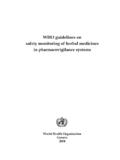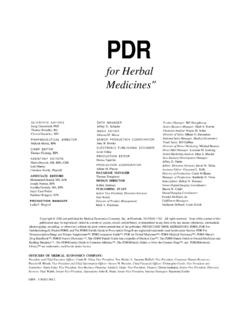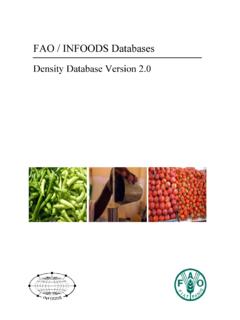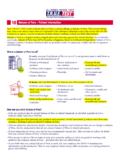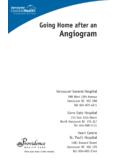Transcription of 1 National policy on traditional medicine and …
1 National policy on traditional medicineandregulation of herbal medicines Report of a WHO global survey World Health Organization GenevaMay 2005 World Health Organization 2005 All rights reserved. Publications of the World Health Organization can be obtained from WHO Press, World Health Organization, 20 Avenue Appia, 1211 Geneva 27, Switzerland (tel: +41 22 791 2476; fax: +41 22 791 4857; email: Requests for permission to reproduce or translate WHO publications whether for sale or for noncommercial distribution should be addressed to WHO Press, at the above address (fax: +41 22 791 4806.))
2 Email: designations employed and the presentation of the material in this publication do not imply the expression of any opinion whatsoever on the part of the World Health Organization concerning the legal status of any country, territory, city or area or of its authorities, or concerning the delimitation of its frontiers or boundaries. Dotted lines on maps represent approximate border lines for which there may not yet be full agreement. The mention of specific companies or of certain manufacturers products does not imply that they are endorsed or recommended by the World Health Organization in preference to others of a similar nature that are not mentioned.
3 Errors and omissions excepted, the names of proprietary products are distinguished by initial capital letters. All reasonable precautions have been taken by the World Health Organization to verify the information contained in this publication. However, the published material is being distributed without warranty of any kind, either express or implied. The responsibility for the interpretation and use of the material lies with the reader. In no event shall the World Health Organization be liable for damages arising from its use. Printed in France. WHO Library Cataloguing-in-Publication Data National policy on traditional medicine and regulation of herbal medicines: Report of a WHO global survey.
4 , herbal - standards , herbal - legislation , traditional therapies policy , Medical Health Organization ISBN 92 4 159323 7 (NLM Classification: WB 925) AcknowledgementsiAcknowledgementsThe World Health Organization (WHO) acknowledges its indebtedness to the WHO Member States that provided the information contained in this summary report through the WHO Global Survey on the Regulation of traditional medicine (TM) and Complementary/Alternative medicine (CAM) and the Regulation of herbal Medicines. Thanks are due to the Regional Offices and WHO Representative offices for actively and diligently overseeing the distribution and return of the Global Survey.
5 WHO expresses its sincere appreciation to the Government of Sweden for providing financial support through the Swedish expertise funds to finance the drafting of the global survey form by the team at the Karolinska Institut, Stockholm, Sweden, headed by Dr Torkel Falkenberg. WHO expresses its great appreciation to the Nippon Foundation for financial support through its overseas grant scheme (Project ID 2002225511 and Project ID 2004401227) for the processing of Global Survey data, the establishment of a WHO global database, achieving the objectives set for the Global Survey itself, and the publication of this summary report of the survey results.
6 National policy on traditional medicine and regulation of herbal medicines Report of a WHO global survey iiExecutive summaryiiiExecutive summary Background traditional medicine (TM) has always maintained its popularity worldwide. In addition, over the last decade, we have seen an increasing use of complementary and alternative medicines (CAM) in many developed and developing countries. The safety and efficacy of traditional medicine and complementary and alternative medicines, as well as quality control, have become important concerns for both health authorities and the public. Various traditional medicine practices have been developed in different cultures in different regions, but without a parallel development of international standards and appropriate methods for evaluating traditional medicine .
7 Therefore, sharing National experience and information is crucial. Challenges Countries face major challenges in the development and implementation of the regulation of traditional , complementary/alternative and herbal medicines. These challenges are related to regulatory status, assessment of safety and efficacy, quality control, safety monitoring and lack of knowledge about TM/CAM within National drug regulatory authorities. Challenges related to the regulatory status of herbal medicines: Before manufactured drugs came into widespread use, herbal medicines played an important role in human health. There are great differences between Member States in the definition and categorization of herbal medicines.
8 A single medicinal plant may be defined as a food, a functional food, a dietary supplement or a herbal medicine in different countries, depending on the regulations applying to foods and medicines in each country. This makes it difficult to define the concept of herbal medicines for the purposes of National drug regulation, and also confuses patients and consumers. Challenges related to the assessment of safety and efficacy: Requirements and methods for research and evaluation of the safety and efficacy of herbal medicines are more complex than those for conventional pharmaceuticals. A single medicinal plant may contain hundreds of natural constituents, and a mixed herbal medicinal product may contain several times that number.
9 If every active ingredient were to be isolated from every herb, the time and resources required would be tremendous. Such an analysis may actually be impossible in practice, particularly in the case of mixed herbal medicines. Challenges related to quality control of herbal medicines: The safety and efficacy of herbal medicines is closely correlated with the quality of the source materials used in their production. The quality of source materials is, in its turn, determined by intrinsic factors (genetic) and extrinsic factors (environmental conditions, cultivation and harvesting, field collection and post harvest/collection transport and storage).
10 Therefore, it is very difficult to perform quality controls on the raw materials of herbal medicines. Good Manufacturing Practice (GMP) specifies many requirements for quality control of starting materials, including correct identification of species of medicinal plants, special storage and special sanitation and cleaning methods for various materials. In National policy on traditional medicine and regulation of herbal medicines Report of a WHO global survey ivthe quality control of finished herbal medicinal products, particularly mixed herbal products, it is more difficult to determine whether all the plants or starting materials have been included.










